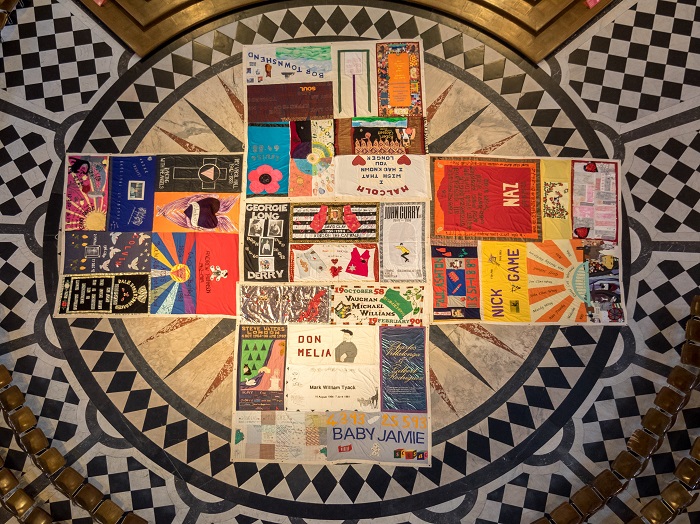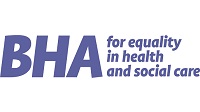People and Parliament: Remembering 30 Years of HIV and AIDS
PEOPLE AND PARLIAMENT: REMEMBERING 30 Years of HIV and AIDS
AN EXHIBITION OF UK AIDS MEMORIAL QUILT PANELS AT WESTMINSTER HALL
27 NOVEMBER - 3 DECEMBER 2017
The exhibition will mark 30 years of HIV in the UK through a narrative focusing on the work of parliament and key parliamentarians from 1980s to the present day. This will be set within the context of the contribution of campaigners from inside and outside Parliament, the changing face of HIV in the UK and remembrance of those who died in the early days.
Alongside this information will tell the story of government engagement in HIV and AIDS, from the ‘Don’t Die of Ignorance’ campaign in 1987 to the funding for the National HIV Prevention programme today; initiatives including the launch of the first national strategy for sexual health and HIV in 2001, universal access to HIV treatments in 2005 to the publishing of ‘The HIV Puzzle’ and the continuing work of the APPG on HIV and AIDS. It will also recognise those who have taken a leadership role in campaigning groups and within parliament such as Lord Kilmarnock, founder of the APPG on AIDS; Baroness Masham of Ilton, who has been a Vice-Chair of the Group since its inception; Lord Fowler who championed action towards HIV in his role as Secretary of State for Health and Baroness Gould of Potternewton who advised the Government as Chair of the Independent Advisory Group on Sexual Health and HIV.
The exhibition will also recognise parliament’s function in scrutinising the work of the Government and the crucial role in effective policymaking to improve the care and treatment for people living with HIV. Select Committees from both Houses have recognised the complex and evolving nature of HIV policy and by gathering evidence from around the world, have sought to improve UK policymaking on domestic and international HIV issues. In 2005, the Health Select Committee published New Developments in Sexual Health and HIV/AIDS policy, challenging the Government’s position of the day on free access to treatment for non-UK nationals resulting in the universal access to treatment in 2012. In 2011, the Lords’ Select Committee on HIV and AIDS, chaired by Lord Fowler, published the No Vaccine, No Cure report, highlighting both the enormous advances in the treatment and care of people living with HIV in the UK and related stigma which preventing people from accessing the testing and treatment. Internationally, the Commons’ International Development Select Committee launched inquiries, in 2009 and 2017, into the Department for International Development’s work on HIV/AIDS globally, on both occasions, praising the Government’s commitment to the Global Fund to fight HIV/AIDS, tuberculosis and malaria, but also pressed the Government to do more to address challenges for grassroots advocates and key populations.
To illustrate the impact upon the community and as an act of remembrance for World AIDS Day on 1 December, the exhibition will include a display of the UK’s AIDS Memorial Quilts to tell the story of individuals who died of AIDS in the 80s and 90s with remembrances from families and friends .
The exhibition will be set up by staff and volunteers from the organisations of the AIDS Memorial Quilt Conservation Partnership who will be at the exhibition throughout its duration to guide visitors through and provide them with further information.
DISPLAYS AND MATERIAL
A series of role-up banners will provide a timeline of government engagement and initiatives to tackle HIV in the UK, and provide in-depth information on specific actions and their impact, and profiles of parliamentarians who played a key role e.g. Lord Fowler.
The UK’s AIDS Memorial Quilt is an irreplaceable piece of social history and remembrance of those who died of HIV and AIDS in the 80s and 90s. The quilt panels measure 12 feet x 12 feet and can be laid out on a floor. The above image shows Panels displayed in St Paul’s Cathedral in 2016:
Alongside the quilts will be A3 stands providing information about those remembered and quotes from those who created the quilts.
Further images of the quilts can be found at http://www.aidsquiltuk.org/gallery/
As we aim to reach as many people as possible over World AIDS Day and due to the size of the AIDS Memorial Quilt panels, Westminster Hall is the only suitable venue for this exhibition
RELEVANCE TO PARLIAMENT?
The story of HIV in the UK and Government’s response is a unique piece of parliamentary history. It is the story of parliament’s intervention to prevent a national epidemic, an intervention that prevented the spread of HIV, saves lives and ensured effective support and care for those affected and challenge HIV related stigma. What is also unique is that the story of HIV from a terminal to long-term condition has happened within our lifetime over the course of 30 years and, as such, has occurred alongside the careers of parliamentarians who were at the vanguard of, and continue to, advocate for the rights of people living with HIV.
When AIDS first appeared in the 1980s it marked, for the first time in the 20th century, the beginning of a potential epidemic in the UK. This was an epidemic disproportionately impacting upon those on the fringes of society at that time, notably gay men, drug users and sex workers.
In the words of Lord Fowler, who was Secretary of State for Health from 1981 to 1987: ‘We were the only people that could protect the public and prevent deaths from taking place’ (Lord Norman Fowler, 2016)
2017 marks the 30th anniversary of the UK Government’s engagement in tackling HIV and supporting people with HIV. Parliament has recognised and addressed issues from raising awareness in 1987 through launching the Don’t Die of Ignorance Campaign and then in 2017 within compulsory relationships and sexual education in secondary schools; testing through the introduction of the ante-natal screening programme in 1999 and legislation for home testing kits in 2014; through to protection of those living with HIV with the inclusion of HIV in the Disability Discrimination Act in 1995, subsequently strengthened in the 2010 Equality Act.












